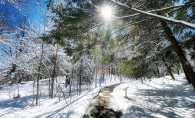“When people come to Cruiser’s Cove, they’re going to see a change,” says Telly Mamayek, communications director for Minnehaha Creek Watershed District. Those boating in Lake Minnetonka this summer will see a new and attractive landscape where jagged, naked cliffs once stood.
In addition to the aesthetic benefits, the project also protects Big Island and the lake itself. Gabriel Jabbour, a community leader from Orono who has a passion for maintaining public resources in the Lake Minnetonka area, says that the island has undergone noticeable changes since he first moved to the area in 1972. “Since I’ve been there, there are cliffs that I walked on that are no longer there,” says Jabbour. “With the rise of the water table and some of the larger vessels on the lake, the island started eroding.”
This erosion has affected numerous aspects of the shore. Mamayek says that it had a negative impact on the littoral zone, the 15 to 20 feet closest to the shore, where fish lay eggs, insects hatch and plants start to grow. This is critical habitat that is essential to maintaining the ecosystem, she says. The Minnehaha Creek Watershed District also knew that as more and more soil washed into the lake, the water quality around Big Island might be affected.
Concerns also grew for animals that make their homes on the shoreline and in Arthur Allan’s Wildlife Sanctuary, which sits to the west of Cruiser’s Cove. Because so much of the shoreline around Lake Minnetonka has been developed, there are already limited places for animals like the kingfisher or soft-shell turtle to lay their eggs. The years of erosion meant that there was even less space on the island for animals to nest.
With these current and potential future problems in mind, in 2009, MCWD and Three Rivers Park District (TRPD) began to fight the erosion on Big Island. They restored 3,000 feet of shoreline along the south and east sides of the island. Jabbour was also instrumental in this project. As with this most recent project, large rocks, known as riprap, were placed along the shoreline to help buffer waves. TRPD then filled soil in between the rocks and planted native species such as willows and dogwoods, all of which were started in TRPD’s nursery.

By all counts, the restoration has been a resounding success. “It’s a natural shoreline with natural habitation,” says John Barten, TRPD’s natural resources director. Mayamek says that these native plants were a key factor in the project’s success; with their deep roots, they’ve stabilized the shoreline. Additionally, the large boulders have shouldered the brunt of wave action, keeping soil and sand on the island, and helping to reduce the loss of mature trees.
In November 2013, TRPD and MCWD partnered to tackle the Cruiser’s Cove shoreline, owned by TRPD. With completion of that stretch of 1,200 feet, all public land has been restored, meaning the island will remain viable for years to come. By sharing resources and splitting the project cost, the agencies did more together than either could do on their own. “It epitomizes the partnerships that occur around Lake Minnetonka to preserve resources,” says Mayamek.
Jabbour agrees. “We are absolutely lucky to have the people to preserve both those pieces of land for future generations,” he says. The agencies have been so successful in their collaborative efforts that other agencies have reached out to them to see what [they’ve done] and how they’ve done it.”
Due to its preservation of public resources through agency partnership, there is renewed life on Big Island’s shoreline.
Visit ci.orono.mn.us for more information about Big Island. For more details on the restoration project, visit minnehahacreek.org/project, the Minnehaha Creek Watershed District’s online source for updates.









